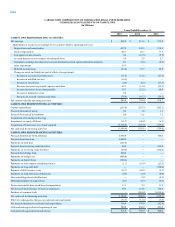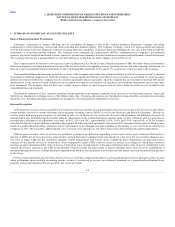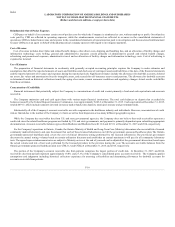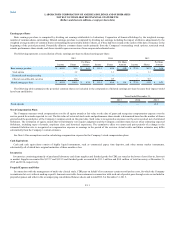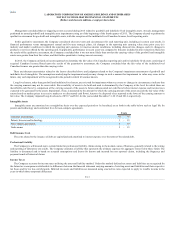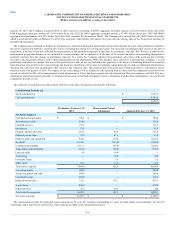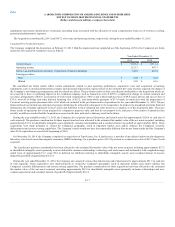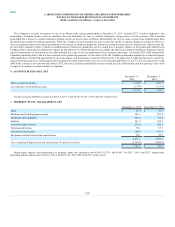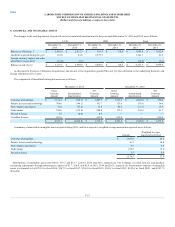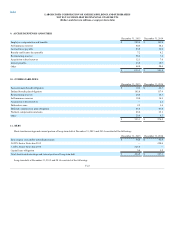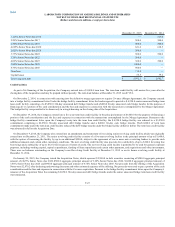LabCorp 2015 Annual Report Download - page 94
Download and view the complete annual report
Please find page 94 of the 2015 LabCorp annual report below. You can navigate through the pages in the report by either clicking on the pages listed below, or by using the keyword search tool below to find specific information within the annual report.
Index
are expected to be recovered or settled. The effect on deferred tax assets and liabilities of a change in tax rates is recognized in income in the period that
includes the enactment date. The Company does not recognize a tax benefit unless the Company concludes that it is more likely than not that the benefit will
be sustained on audit by the taxing authority based solely on the technical merits of the associated tax position. If the recognition threshold is met, the
Company recognizes a tax benefit measured at the largest amount of the tax benefit that the Company believes is greater than 50% likely to be realized. The
Company records interest and penalties in income tax expense.
Interest rate swap agreements, which have been used by the Company from time to time in the management of interest rate exposure, are accounted for at
fair value. The Company’s zero-coupon subordinated notes contain two features that are considered to be embedded derivative instruments under
authoritative guidance in connection with accounting for derivative instruments and hedging activities. The Company believes these embedded derivatives
had no fair value at December 31, 2015 and 2014.
See Note 18 for the Company’s objectives in using derivative instruments and the effect of derivative instruments and related hedged items on the
Company’s financial position, financial performance and cash flows.
Fair value measurements for financial assets and liabilities are determined based on the assumptions that a market participant would use in pricing an
asset or liability. A three-tiered fair value hierarchy draws distinctions between market participant assumptions based on (i) observable inputs such as quoted
prices in active markets (Level 1), (ii) inputs other than quoted prices in active markets that are observable either directly or indirectly (Level 2) and (iii)
unobservable inputs that require the Company to use present value and other valuation techniques in the determination of fair value (Level 3).
The Company expenses R&D costs as incurred.
For subsidiaries outside of the U.S. that operate in a local currency environment, income and expense items are translated to U.S. Dollars at the monthly
average rates of exchange prevailing during the period, assets and liabilities are translated at period-end exchange rates and equity accounts are translated at
historical exchange rates. Translation adjustments are accumulated in a separate component of shareholders’ equity in the consolidated balance sheets and
are included in the determination of comprehensive income in the consolidated statements of comprehensive earnings and consolidated statements of
changes in shareholders’ equity. Transaction gains and losses are included in the determination of net income in the consolidated statements of operations.
In April 2014, the FASB issued a new accounting standard on discontinued operations that significantly changed criteria for discontinued operations and
disclosures for disposals. Under this new standard, to be a discontinued operation, a component or group of components must represent a strategic shift that
has (or will have) a major effect on an entity's operations and financial results. Expanded disclosures for discontinued operations include more details about
earnings and balance sheet accounts, total operating and investing cash flows, and cash flows resulting from continuing involvement. The Company has
adopted the guidance of this new standard effective beginning of 2015 and will apply it prospectively to all new disposals of components and new
classifications as held for sale. The adoption of this standard did not have a material impact on the consolidated financial statements.
In May 2014, the FASB issued the converged standard on revenue recognition with the objective of providing a single, comprehensive model for all
contracts with customers to improve comparability in the financial statements of companies reporting using International Financial Reporting Standards and
U.S. Generally Accepted Accounting Principles. The standard contains principles that an entity must apply to determine the measurement of revenue and
timing of when it is recognized. The underlying principle is that an entity must recognize revenue to depict the transfer of goods or services to customers at
an amount that the entity expects to be entitled to in exchange for those goods or services. An entity can apply the revenue standard retrospectively to each
prior reporting period presented (full retrospective method) or retrospectively with the cumulative effect of initially applying the standard recognized at the
date of initial application in retained earnings. As originally issued, the new revenue recognition standard would be effective for the Company beginning
January 1, 2017. On July 9, 2015, the FASB approved the proposal to defer the effective date of this standard by one year. The standard will be effective for
the Company beginning January 1, 2018,
F-14




